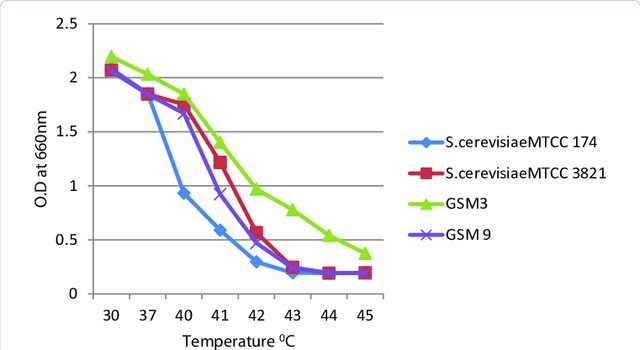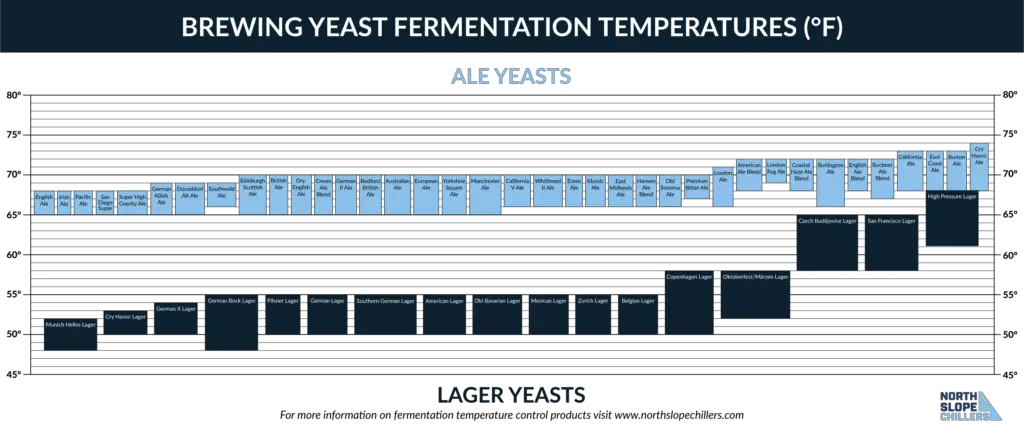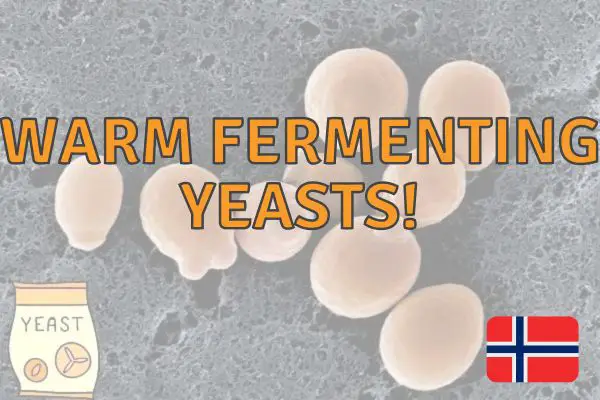As a seasoned brewer, I’ve often puzzled over the role of yeast in brewing. This seemingly insignificant ingredient plays an enormous role in the final taste, aroma, and overall character of your brew.
There’s a multitude of yeast strains available, each with its own specific qualities. So how do you pick the right one for your brew?
One important factor to consider is temperature tolerance. In this post, we’ll dive into the best high temperature yeast strains.
Here’s are some of the best high-temperature yeast strains used in brewing:
| Yeast Strain | Description | Fermentation Temperature Range |
|---|---|---|
| Lallemand Voss Kveik Ale Yeast | Traditional dried yeast used in Norwegian farmhouse brewing. Produces neutral flavor with subtle fruity notes. Ideal for quick beer production in warm climates. High flocculation. | 35-40°C (95-104°F) |
| Wyeast 1388 | Liquid beer yeast isolated from traditional Belgian Strong Ale. Suitable for high gravity Belgian ales, especially Golden Strong Ales. Tolerates up to 12-13% ABV. | 18-27°C (64-80°F) |
| Fermentis SafAle US-05 | American ale brewer’s yeast for neutral and well-balanced ales. Forms a firm foam head, ideal for American and highly hopped beers. | 18-28°C (64-82°F) |
| Lalvin EC-1118 | Ideal for reaching high alcohol content in beer. Use for secondary fermentation in super high gravity beers. Suitable for making strong alcoholic beverages. | 15-30°C (59-86°F) |
| Mangrove Jack’s M42 | Versatile yeast with a wide temperature range. Suitable for various beer styles and can handle up to 9% ABV. | 16-28°C (61-82°F) |
High-temperature yeast strains are critical e.g. in Ale or turbo-wine brewing because they allow for fermentation at higher temperatures without producing off-flavors.
This makes them ideal for brewing in warmer climates or during the summer months when control over temperature might be challenging.
Top High-Temperature Yeast Strains
There are many high-temperature yeast strains to choose from, but here are some of the best based on my personal experience and widespread use in the brewing community:
1. Lallemand Voss Kveik Ale Yeast
Lallemand Voss Kveik Ale Yeast is a traditional dried yeast that has been used in Norwegian farmhouse brewing for generations.

It is perhaps the yeast strain with the highest temperature range of brewing yeasts.
And it is really one of my favorite beer yeast strains of all time, which is why I have dedicated most of this article to the Kveik yeast (make sure to read detailed walkthrough of Kveik later in this article!).
This yeast supports a wide, but very high, range of fermentation temperatures between 25-40°C (77-104°F) with a very high optimal range of 35-40°C (95-104°F).
The LalBrew Voss™ strain was obtained from Sigmund Gjernes (Voss, Norway), who has maintained this culture using traditional methods since the 1980s and generously shared it with the wider brewing community.

Very fast fermentations are achieved within the optimal temperature range with full attenuation typically achieved within 2-3 days.
The flavor profile is consistent across the entire temperature range: neutral with subtle fruity notes of orange and citrus.
The ability to ferment at high temperatures makes Lallemand Voss Kveik Ale Yeast an excellent choice for brewers looking to produce beer quickly, especially in warmer climates.
Additionally, its high flocculation produces clear beers.
Overall, Lallemand Voss Kveik Ale Yeast is a versatile and reliable yeast that can produce excellent results in a variety of brewing conditions.
See more at Lallemands homepage.
2. Wyeast 1388
This strain has an ideal fermentation temperature range of 64-80°F (18-27°C). It’s a liquid beer Yeast isolated from traditional Belgian Strong Ale – so Wyeast 1388 is another good option if brewing high gravity Belgian ale beers, especially Golden Strong Ales. It can tolerate up to about 12-13% ABV.
3. Fermentis SafAle US-05
Fermentis SafAle US-05 is a versatile brewer’s yeast for neutral ales. It is an American ale brewer’s yeast that produces neutral and well-balanced ales, clean and crispy.

It forms a firm foam head and presents a very good ability to stay in suspension during fermentation.
It is ideal for American beer types and highly hopped beers. According to Fermentis, the ideal temperature range for using SafAle US-05 is 18-28°C (64-82°F), but according to 3rd party (home brewer) tests, it ferments optimally at 28C and is still quite good until around 34C.
4. Lalvin EC-1118 all-around yeast
Lalvin EC-1118 produced by Lallemand Brewing is a robust and reliable yeast strain that is known for its neutral sensory contribution to wine.

It is used extensively in the world for the production of both white and red wines, and is highly recommended for secondary fermentation.
According to Lallemand Brewing, the desirable fermentation temperature range for Lalvin EC-1118 is 10-30°C (50-86°F).
5. Mangrove Jack’s M42
Mangrove Jack’s M42 New World Strong Ale Yeast is a top-fermenting ale strain suitable for many types of ales of all strengths.

It ferments with a neutral yeast aroma to ensure the full character of the malts and hops are prominent in each beer. This strain has an optimal temperature range of 16-28°C (61-82°F).
For best results, it is recommended to ferment at 16-22 degrees C (61-72 degrees F), but in my experience it works well up to around 30C (86F).
It is suitable for IPA’s, Porters, Russian Imperial Stouts and more. Its high attenuation (77 – 82%) and very high flocculation make it a great all-around workhorse for beer brewing.
The Importance of Yeast in Brewing
Yeast is a critical ingredient in brewing. It’s responsible for the fermentation process, where it consumes the sugars in the wort (unfermented beer) and produces alcohol, carbon dioxide, and other compounds that contribute to the beer’s flavor.

Different strains of yeast behave differently during fermentation and create diverse flavor profiles. Some strains are better suited to colder temperatures, while others thrive in warmer conditions. Choosing the right yeast strain for your brew is incredibly important.
Understanding High-Temperature Yeast Strains
While “ordinary” yeast strains typically ferment best at temperatures ranging from 15°C to 24°C (59°F to 75°F), they do not actually die off before the late 30C or around 40C (104F).
After that they pretty much stop growing:

High-temperature yeast strains, most often being ale yeast, are able to ferment at warmer temperatures without producing off-flavors.
Ale and lager yeasts: The highs and lows of fermentation temperature optimums!
Ale and lager yeast are two distinct strains of yeast commonly used in the brewing industry to produce different types of beer.

They differ not only in terms of the flavors they impart but also in their optimal fermentation temperatures and the reasons behind these differences.
Ale Yeasts:
- Ale yeast, most being Saccharomyces cerevisiae, is a top-fermenting yeast strain. It ferments at warmer temperatures compared to lager yeast.
- Optimal fermentation temperature for ale yeast typically ranges from 60°F to 75°F (15°C to 24°C). Some ale yeast strains may even tolerate slightly higher temperatures.
- The warmer fermentation temperatures associated with ale yeast lead to a faster fermentation process. This results in a beer with a quicker turnaround time, often ready to drink in a matter of weeks.
- Ale yeast produces a wider range of flavors and aromas, including fruity esters and spicy phenols, which contribute to the complex and diverse flavor profiles found in ales. These flavors are often more pronounced due to the higher fermentation temperatures.
Lager Yeasts:
- Lager yeast, scientifically known as Saccharomyces pastorianus, is a bottom-fermenting yeast strain. It ferments at cooler temperatures compared to ale yeast.
- Optimal fermentation temperature for lager yeast typically ranges from 45°F to 55°F (7°C to 13°C). Some lager yeast strains may require even cooler temperatures, especially for traditional lager styles.
- The colder fermentation temperatures associated with lager yeast result in a slower fermentation process. Lager beers often require a longer maturation period, sometimes several months, to reach their optimal flavor.
- Lager yeast produces fewer esters and phenols compared to ale yeast. This results in a cleaner and crisper flavor profile with a focus on malt and hops characteristics. Lager beers are known for their subtlety and balance.
Why the Temperature Difference?
- The primary reason for the difference in optimal fermentation temperatures between ale and lager yeast lies in their evolutionary history and adaptation.
- Ale yeast strains have developed to thrive in warmer temperatures, as they were historically used in regions with milder climates. Their ability to ferment at higher temperatures allows for a quicker brewing process.
- Lager yeast strains, on the other hand, have adapted to cooler temperatures, often found in regions with cold winters and caves. Their slow, cool fermentation process contributes to the clean and crisp profile of lager beers.
- Temperature also influences the production of fermentation byproducts. Ale yeast, fermenting at warmer temperatures, generates more esters and phenols, while lager yeast, fermenting at cooler temperatures, minimizes these compounds.
In summary, ale and lager yeast are two distinct types of yeast with different optimal fermentation temperatures and flavor profiles.
These differences are rooted in their evolutionary history and adaptation to specific environmental conditions.
Brewers carefully select the yeast strain and fermentation temperature to achieve the desired characteristics in their beer, whether it’s a fruity and complex ale or a clean and crisp lager.
This makes them ideal for brewing in warmer climates or during the summer months when control over temperature might be challenging.
The Kveik Yeasts: Thermophile Yeasts From The Cold North!
In the world of brewing, one of the most intriguing yeasts, gaining popularity in recent years, has been the remarkable kveik yeasts, a group of yeast strains originating from the cold Scandinavian country of Norway.

What’s truly fascinating about these yeasts is their incredible ability to thrive and ferment at high temperatures, a trait that might seem ironic considering their Nordic origins.
Origin and Evolution of Kveik Yeasts
Kveik yeasts have a rich history deeply rooted in Norwegian and Scandinavian brewing traditions. Historically, these yeasts were used in traditional farmhouse brewing practices.
Brewers in these regions would pitch kveik yeast into warm, strong wort, often exceeding 30ºC (86ºF), and store the yeast for extended periods between brewing sessions, sometimes up to a year.
This unique brewing environment, with its high-temperature fermentation and prolonged storage, laid the foundation for the evolution of kveik yeasts.

Contrast this with modern commercial brewing practices, where American Ale yeasts like the well-known ‘Chico’ (SafAle US-05) are often repitched into relatively cool and standard strength wort, typically around 18-20ºC (64-68ºF).
The differences in temperature and usage over many generations have likely led to distinct adaptations in kveik yeasts compared to their American Ale counterparts.
Adaptation to High Temperatures
Recent research has shed light on the remarkable temperature adaptability of kveik yeasts.
Several kveik strains, including Lalbrew Voss, Omega Lutra, and Escarpment Laerdal, were subjected to a range of fermentation temperatures, from moderate to extremely high.
The results provide valuable insights into how these yeasts perform and adapt at various temperature regimes.
Figures 1 and 2 (panel C) from the research (see below) illustrate the fermentation performance of Lalbrew Voss kveik at different temperatures.

It’s evident that temperature significantly influences the fermentation properties of Voss kveik. Notably, the triplicate ferments at 33.5ºC and 37ºC exhibit the fastest fermentation rates, reaching terminal gravity in remarkably short timeframes (less than 40 hours!).
In contrast, the 20ºC ferment is notably slower, and the 42ºC ferment is even slower than the 28ºC one. This data indicates that Voss kveik is inhibited at temperatures of 40ºC and above.

Figure 2 highlights the maximum fermentation rate for Voss kveik at various temperatures, showing that the optimum temperature for this yeast strain is around 37ºC. This aligns with our earlier research, confirming that kveik yeasts indeed thrive at elevated temperatures.
Surprisingly, the apparent attenuation of Voss kveik remained consistent across the temperature gradient, hovering around 77% from 20ºC to 42ºC.
This stability in attenuation is noteworthy, as other yeasts, such as Lutra and Laerdal kveik, show decreased attenuation at higher temperatures due to temperature-induced stress.
The Irony of Kveik’s Cold Origins
What makes the adaptation of kveik yeasts to high temperatures even more intriguing is the irony of their cold Scandinavian origins.
These yeasts, which have become synonymous with high-temperature brewing, emerged from a region known for its chilly climate.
The fact that they’ve evolved to thrive in elevated temperatures demonstrates the remarkable adaptability of microorganisms and highlights the importance of traditional brewing practices in shaping yeast characteristics.
In conclusion, kveik yeasts have emerged as a testament to the interplay between tradition, evolution, and adaptation in the world of brewing.
Their ability to ferment at high temperatures, despite originating from a cold region, showcases the dynamic nature of yeast and the fascinating ways in which it has been harnessed by brewers over centuries.
As we continue to uncover the mysteries of yeast biology and brewing, kveik yeasts stand as a testament to the rich tapestry of beer’s history and evolution.
Care and Handling of High-Temperature Yeast Strains
The handling and care of your yeast strains are as important as the strain you choose. Yeast is a living organism and needs to be treated as such. Always store your yeast in a cool, dark place and use it before the expiration date.
When ready to use, rehydrate dry yeast or make a starter for liquid yeast. This ensures the yeast is healthy and ready to start the fermentation process.
Conclusion
As we’ve seen, the choice of yeast strain plays a crucial role in brewing. High-temperature yeast strains offer the advantage of being able to ferment at higher temperatures without producing off-flavors.
However, it’s important to choose a strain that fits the style of beer you’re brewing and handle it properly to ensure a successful fermentation.
From my personal experience, using high-temperature yeast strains like Kveik has provided me with a greater flexibility in brewing in different seasons, climates and speeds!
It has also allowed me to experiment with a larger variety of beer styles. Remember, the world of brewing is expansive and creative, so don’t be afraid to experiment, taste, and learn as you go. Happy brewing!
FAQs
What type of yeast ferments the fastest?
Kveik yeasts can ferment really fast due to their high temperature optimum.
What is the best yeast for high temperatures?
The best yeast for high temperatures is the Lalleman Voss Kveik. It is known for its ability to tolerate higher temperatures during fermentation processes, making it suitable for brewing beer and other alcoholic beverages.
Which type of yeast prefers fermenting at warmer temperatures?
Ale yeasts. Certain strains of yeast, such as Saccharomyces cerevisiae, are known to prefer fermenting at warmer temperatures.
What yeast yields the most alcohol?
High-tolerance yeasts such as Lalvin EC-118 is a good example of a versatile yeast yielding up to 18% ABV.
What is the fastest acting yeast for alcohol?
The fastest acting yeast for alcohol production is typically engineered strains of Saccharomyces cerevisiae, commonly known as brewer’s yeast. This yeast is known for its ability to efficiently convert sugars into alcohol, making it a popular choice for fast fermentation. The fastest straisn do not make good tasting beer though and are mostly used for (bio)ethanol production.
What is the best yeast for warm fermentation?
The best yeast for warm fermentation is generally a strain of Kveik or Belgian Saison yeasts, or the California Ale yeast. These yeast strains are known for their ability to tolerate higher temperatures and produce desirable flavors when fermented at warmer temperatures.




